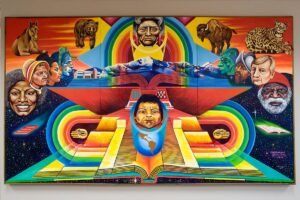
Last month, Guidestar and the Foundation Center announced a strategic partnership between the two leading sources of data on nonprofits and foundations. The purpose, according to the press release, is “to build the capacity and effectiveness of the social sector…[by] leverag(ing) the organizations’ unique strengths and complementary missions to support the field in new and innovative ways.” The buzzwords of “partnership,” “alliance,” “capacity,” “effectiveness,” and “innovative” are pretty common to everyone’s new business plan, but in this case, with Guidestar’s Jacob Harold and the Foundation Center’s Brad Smith driving the dynamic, there might be something happening worth watching and using.
If you live on data about the nonprofit sector, as we do at Nonprofit Quarterly, you spend a good chunk of your time at the Foundation Center and Guidestar websites, sometimes trucking back and forth between the two to put together the fullest possible picture of individual nonprofits or nonprofit subsectors. Even as Guidestar and the Foundation Center have evolved and made their databases more accessible and navigable—though, in many cases, for a price—the data picture of the nonprofit sector has been one of fragments stitched together primarily through the diligence of the researcher, often with significant gaps or data filled in by the use of substitute measures that are only guesses as to the real nonprofit dynamic. This partnership between the two organizations has the potential, as Harold explains to Nonprofit Quarterly, of “bringing some order to…the information architecture [that] can help define the community; it is about having clarity about what we mean by ‘we’ in the nonprofit sector.”
Why not simply merge, and have one of these data inventories absorb the other and become one large organization? In contrast to the scalability juggernaut that has captured the attention of much of the sector, Smith tells NPQ that the route to bigger impact isn’t through a bigger organization, but networking.
Ultimately, according to Harold, this bilateral partnership could evolve into a multilateral relationship with other entities that chew and interpret nonprofit data, but at the moment, there is a natural reason for these two to come together in an alliance. According to Smith, “no one knows more about the care, feeding, and handling of [Form] 990s” than Guidestar and the Foundation Center. The bulk of 990s, Smith says, are not submitted digitally, and even if government plans do proceed for requiring the digitization of 990s, it won’t happen for several years. With their decades of experience, the two organizations know what they’re getting in the 990s they receive from the IRS, and how to make sense of the data.
Medium Data Defining the Field
The term of the moment is “big data,” but Harold defines a “medium data” challenge that has to be mastered before delving into the search for meaning in massive databases. Earlier this year, in a piece for the Harvard Business Review, Harold wrote, “For nonprofits, medium data is a humbler but essential prerequisite: structured information about who you are, what you’re trying to do, and what’s happening.”
What does it mean to be a nonprofit? What kinds of common information help define the nonprofit sector without falling into the trap of magically thinking that some quantitative factors will be able to replace experience and intuition in identifying nonprofits worthy of support and promotion? That’s where Smith and Harold seem to have their feet planted pretty firmly in reality. Both have enough practical experience, particularly as grantmakers—Harold at the Hewlett Foundation and Smith at the Ford Foundation and the Oak Foundation—that they don’t seem to have gone overly giddy about the magic of numbers as substitutes for judgment and common sense in nonprofit decision-making.
Elements of a Strategic Alliance
The strategic partnership between the two data behemoths actually builds on past interactions and collaborations, turning those ad hoc interactions into a more systematic working relationship. What does a strategic partnership between two well-respected and generally successful entities actually mean? Partly, the answer is in organizational synergies. For example, Harold reports that the two organizations plan to align their processes for digitizing Form 990 data. It may not be a big thing, but as is well known, the IRS makes 990s available to Guidestar, the Foundation Center, and other entities as pictures or images. It takes costly effort on the part of data miners like these organizations to pull out information for searchability and interpretation. By working together, this is a strategic alliance that might at a minimum meet an important threshold of cost savings, reducing some of the duplication that occurs between the two organizations handling 990s right now.
A second element may be the broader question of open data, which is, as Harold says, “very much the way the world is going.” By a strategic alignment, the two entities have the ability to work together to open up coordinated pieces of their data infrastructure, and find ways of paying for the data at the same time—in Harold’s words, “how do we advance our missions while keeping our organizations alive, more than alive, but thriving?”
Sign up for our free newsletters
Subscribe to NPQ's newsletters to have our top stories delivered directly to your inbox.
By signing up, you agree to our privacy policy and terms of use, and to receive messages from NPQ and our partners.
A third part of the evolution of this strategic partnership is likely to be co-product development, drawing on the different parts of the Guidestar and Foundation Center databases. As it is, the two organizations have been collaborating on various projects that one might bring to the other, but co-development means meshing different organizational cultures. The Foundation Center’s focus has been on philanthropy, while Guidestar’s has been on other nonprofits. Given two no-longer-young organizations—the Foundation Center has been operating for 57 years and maintains a number of field offices, for example—Smith and Harold don’t foresee a huge organizational culture class challenge, but they would be unwise to overlook the issue.
Strategic Building Blocks
Already, the two organizations have a number of joint projects, often involving third parties such as Tech Soup and Global Giving. The project involving those two entities is the Bridge Project. Smith explains it as “a project to create a unique identifier system for nonprofits on a global scale, a digital code that identifies the uniqueness of an individual nonprofit…comparable to Carfax or the ISBN numbers for books.” One might think that nonprofits are easily identified and authenticated through their federal Employer Identification Numbers (EINs), but Smith explains that the EINs are not 100 percent accurate; sometimes, they are attached to organizations that are no longer functioning or substantially different from the entities that were first linked to the EINs. In addition, outside the U.S., many countries do not have a system comparable to EINs. This project should be hugely beneficial in making it easier for donors to authenticate the U.S. and non-U.S. charities they are trying to give to, giving them the ability to use online giving platforms and other mechanisms to identify the organizations they want to assist with a higher level of certainty.
Smith also talks about another joint project, working with the Media Impact Funders affinity group to develop interactive visualization tools to show which organizations are receiving media grants and which funders are supporting the media. It is a project that expresses the information architecture issue that Harold raises. By developing this project, to be formally launched later this fall, Guidestar, the Foundation Center, and the affinity group will be using data to identify which organizations are actually working in the “media space”—in essence, building the data architecture for what constitutes nonprofit media and foundation-assisted media.
Smith has been at building this relationship for longer than Harold, having had regular meetings with Harold’s predecessor to discuss how they saw the changing nonprofit sector landscape. With Harold’s taking the helm at Guidestar, the relationship became more formalized, reaching the stage of a cooperative agreement. According to Smith, there is enough complementarity in the two organizations’ audiences and products to suggest a positive trajectory for the alliance. Already, Smith says, the organizations’ communications and marketing teams have been meeting regularly to exchange information and discuss new products and services, cross-promotion, and joint webinars.
For many people, discussions of quantitative information are just so much white noise, particularly from the promoters that would lead one to think that for-profit entities are ready, willing, and able to make digitized 990 data available just for the asking. It’s not that easy, by a long shot. Moreover, whatever one might think of various organizations in the nonprofit “infrastructure,” unlike the entrepreneurs who think that they are about to make a killing in the market from somehow accessing and providing machine-readable nonprofit data, Guidestar and the Foundation Center are parts of the nonprofit sector itself. They care about the sector they are hoping to describe through building a more robust information architecture. If nonprofits think that it doesn’t matter what kinds of organizations are helping the nonprofit sector to find and access information to better define what it does, then they have lost a sense of what it means to be a nonprofit.
The identity of a nonprofit is more than a 501(c) tax status. As Smith notes, the nonprofit sector’s appetites and demand for information are not decreasing but, in many ways, shifting, looking for sharper definition of various nonprofit issues. Much like the media funding project, what data might be generated on the grantmaking of foundations to nonprofits working on black male achievement? What data would identify the organizations around the world working on water access and hygiene? Having more access to data from these nonprofit entities will create demand for profiles of the funders and the grant recipients in arenas that don’t fit the broad categorical outlines so often used to describe nonprofits.
Unlike their for-profit competitors, what Guidestar and the Foundation Center might be able to do, if their alliance evolves in a positive way, is help nonprofits “frame and contextualize” information. With more information available, Smith says, “framing the information will be more and more important…it will push people up the value chain.” It isn’t just making data available, but “adding the intellectual value” of the two organizations. Smith points out that for the Foundation Center’s own data on foundation grant flows, “every time a foundation makes a grant to an organization, we look through some 20 sources to verify the integrity of the information, we add coding to it in terms of what the organization does, we try to correct for the obvious mistakes.” He adds, “The idea that information is going to be out there and magic is going to happen is a little naïve. People will realize that it will take to make data valuable.”
Prospects for Strategic Success
Smith admits that the nonprofit “sector is sort of littered with these agreements that people sign about intent, but the way you really partner is to work on things that are concrete.” By taking on projects like the media funders piece and the Bridge Project, Guidestar and the Foundation Center are “learning about the potentials…[making the partnership more than] just CEO-deep.”
Like Harold, Smith’s enthusiasm for the effort is almost palpable. “This is so thought through,” Smith says. “It felt like the right thing to be doing after all that led up to it. What we do is incredibly complementary. This is a fantastic time to be working in this sector with data and technology, because data and technology world is exploding around it, but the sector is weak in data and technology.” In Harold’s words from his HBR article, “It’s time for every nonprofit leader to step up to the challenge of data. Fear not: It doesn’t require terabytes of data and supercomputers. Medium data is simply organized storytelling—and if there’s one thing nonprofits do well, it’s tell stories about the need in our communities. Now is the time for us to tell an honest, open, shared story about ourselves.”
The Guidestar/Foundation Center announcement of a strategic partnership or strategic alliance may sound like a story about numbers and more numbers. To us, it is entirely different. It is an evolving story about how the nonprofit sector comes to see, define, and explain itself to the outside world.











